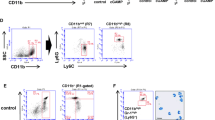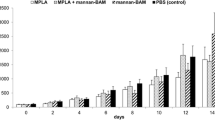Abstract
Tumor cell expansion relies on nutrient supply, and oxygen limitation is central in controlling neovascularization and tumor spread. Monocytes infiltrate into tumors from the circulation along defined chemotactic gradients, differentiate into tumor-associated macrophages (TAMs), and then accumulate in the hypoxic areas. Elevated TAM density in some regions or overall TAM numbers are correlated with increased tumor angiogenesis and a reduced host survival in the case of various types of tumors. To evaluate the role of TAMs in tumor growth, we here specifically eliminated TAMs by in vivo application of dichloromethylene diphosphonate (DMDP)-containing liposomes to mice bearing various types of tumors (e.g., B16 melanoma, KLN205 squamous cell carcinoma, and 3LL Lewis lung cancer), all of which grew in the dermis of syngeneic mouse skin. When DMDP-liposomes were injected into four spots to surround the tumor on day 0 or 5 after tumor injection and every third day thereafter, both the induction of TAMs and the tumor growth were suppressed in a dose-dependent and injection number-dependent manner; and unexpectedly, the tumor cells were rejected by 12 injections of three times-diluted DMDP-liposomes. The absence of TAMs in turn induced the invasion of inflammatory cells into or around the tumors; and the major population of effector cells cytotoxic against the target tumor cells were CD11b+ monocytic macrophages, but not CCR3+ eosinophils or Gr-1+ neutrophils. These results indicate that both the absence of TAMs and invasion of CD11b+ monocytic macrophages resulted in the tumor rejection.







Similar content being viewed by others
Abbreviations
- AIM:
-
Allograft-induced macrophage
- DMDP:
-
Dichloromethylene diphosphonate
- E/T:
-
Effector/target
- FACS:
-
Fluorescence-activated cell sorter
- FCS:
-
Fetal calf serum
- i.d.:
-
Intradermally
- mAb:
-
Monoclonal antibody
- PBS:
-
Phosphate-buffered saline
- PE:
-
Phycoerythrin
- TAMs:
-
Tumor-associated macrophages
References
Ascher NL, Ferguson RM, Hoffman R, Simmons RL (1979) Partial characterization of cytotoxic cells infiltrating sponge matrix allografts. Transplantation 27:254–259
Bethwaite PB, Holloway LJ, Yeong ML, Thomton A (1993) Effect of tumor associated tissue eosinophilia on survival in women with stage 1B carcinoma of the uterine cervix. J Clin Pathol 46:1016–1020
Burton JL, Wells JM, Corke KP, Maitland N, Hamdy FC, Lewis CE (2000) Macrophages accumulate in avascular, hypoxic areas of prostate tumors: implications for the targeted therapeutic gene delivery to such sites. J Pathol 192:8A
Cario E, Formi G, Lollini P, Modesti A, Musiani P (2008) The intriguing role of polymorphonuclear neutrophils in antitumor reactions. Blood 97:339–345
Collingridge DR, Hill SA, Chaplin DJ (2001) Proportion of infiltrating IgG-binding immune cells predict for tumor hypoxia. Br J Cancer 84:626–630
Delemarre FGA, Kors N, Kraal G, Van Rooijen N (1990) Repopulation of macrophages in popliteal lymph nodes of mice after liposome mediated depletion. J Leukoc Biol 47:251–257
Engers HD, Glasebrook AL, Sorenson GD (1982) Allogeneic tumor rejection induced by the intravenous injection of Lyt-2+ cytotoxic T-lymphocyte clones. J Exp Med 156:1280–1285
Fauci AS, Harley JB, Roberts WC, Ferrans VJ, Gralnick HR, Bjornson BH (1982) NIH conference. The idiopathic hypereosinophilic syndrome. Clinical, pathophysiologic, and therapeutic considerations. Ann Intern Med 97:78–92
Fernandez-Acenero MJ, Galindo-Gallego M, Sanz J, Aljama A (2000) Prognostic influence of tumor-associated eosinophilic infiltrate in colorectal carcinoma. Cancer 88:1544–1548
Fleisch H (1989) Bisphosphonates: a new class of drugs in diseases of bone and calcium metabolism. Recent Results Cancer Res 116:1–28
Goldsmith MM, Belchis DA, Cresson DH, Merritt WD, Askin FB (1992) The importance of the eosinophils in head and neck cancer. Otolaryngol Head Neck Surg 106:27–33
Green MI, Fujimoto S, Sehon AH (1977) Regulation of the immune response to tumor antigens. III. Characterization of thymic suppressor factor(s) produced by tumor-bearing host. J Immunol 119:757–764
Isaacson NH, Rapoport P (1946) Eosinophilia in malignant tumors: its significance. Ann Intern Med 25:893–902
Ishibashi S, Ohashi Y, Suzuki T, Miyazaki S, Moriya T, Satomi S, Sasano H (2006) Tumor-associated tissue eosinophilia in human esophageal squamous cell carcinoma. Anticancer Res 26:1419–1424
Krist LF, Kerremans M, Koenen H, Blijleven N, Eestermans IL, Calame W, Meyer S, Beelen RH (1995) Novel isolation and purification method permitting functional cytotoxicity studies of macrophages from milky spots in the greater omentum. J Immunol Methods 184:253–261
Lange P (1960) Clinical and histological studies on cervical carcinoma: precancerosis, early metastasis, and tubular structures in lymph nodes. Acta Pathol Microbiol Scand 50:1–162
Leek RD, Lewis CE, Whitehouse R, Greenall M, Clarke J, Harris AL (1996) Association of macrophage infiltration with angiogenesis and prognosis in invasive breast carcinoma. Cancer Res 56:4625–4629
Lewis C, Murdoch C (2005) Macrophage responses to hypoxia. Implications for tumor progression and anti-cancer therapies. Am J Pathol 167:627–635
Moghimi SM, Patel HM (1988) Tissue specific opsonins for phagocytic cells and their different affinity for cholesterol-rich liposomes. FEBS Lett 233:143–147
Morokata T, Suzuki K, Masunaga Y, Taguchi K, Morihira K, Sato I, Fujii M, Takizawa S, Torii Y, Yamamoto N, Kaneko M, Yamada T, Takahashi K, Shimizu Y (2006) A novel, selective, and orally available antagonist for CC chemokine receptor 3. J Pharmacol Exp Ther 317:244–250
Musiani P, Allione A, Modica A, Lollini PL, Giovarelli M, Cavallo F, Belardelli F, Forni G, Modesti A (1996) Role of neutrophils and lymphocytes in inhibition of a mouse mammary adenocarcinoma engineered to release IL-2, IL-4, IL-7, IL-10, IFN-α, IFN-γ, and TNF-α. Lab Invest 74:146–157
Nakamura M, Shibazaki M, Nitta Y, Endo Y (1998) Translocation of platelets into Disse spaces and their entry into hepatocytes in response to lipopolysaccharides, interleukin-1 and tumor necrosis factor: the role of Kupffer cells. J Hepatol 28:991–999
Negus RP, Stamp GW, Hadley J, Balkwill FR (1997) Quantitative assessment of the leukocyte infiltrate in ovarian cancer and its relationship to the expression of C-C chemokines. Am J Pathol 150:1723–1734
Noffz G, Qin Z, Kopf M, Blankenstein T (1998) Neutrophils but not eosinophils are involved in growth suppression of IL-4-secreting tumors. J Immunol 160:343–350
Ohno S, Ohno Y, Suzuki N, Kamei T, Koike K, Inagawa H, Kohchi C, Soma G-I, Inoue M (2004) Correlation of histological localization of tumor-associated macrophages with clinicopathological features in endometrial cancer. Anticancer Res 24:3335–3342
Rheinbach G (1893) Uber des verhalten der leukozyten bei malignen tumoren. Arch Klin Chir 46:486–562
Rothenberg M (1998) Eosinophilia. N Engl J Med 338:1592–1600
Ryman BE, Tyrrell DA (1980) Liposomes-bags of potential. Essays Biochem 18:49–98
Sassler AM, McClatchey KD, Wolf GT, Fisher SG (1995) Eosinophilic infiltration in advanced laryngeal squamous cell carcinoma. Veterans Administration Laryngeal Cooperative Study Group. Laryngoscope 105:413–416
Scholl SM, Pallud C, Beuvon F, Hacene K, Stanley ER, Rohschneider L, Tang R, Pouillart P, Lidereau R (1994) Anti-colony-stimulating factor-1 antibody staining in primary breast adenocarcinomas correlates with marked inflammatory cell infiltrates and prognosis. J Natl Cancer Inst 86:120–126
Shannon AM, Bouchier-Hayes DJ, Condron CM, Toomey D (2003) Tumor hypoxia, chemotherapeutic resistance and hypoxia-related therapies. Cancer Treat Rev 29:297–307
Suzuki K, Morokata T, Morihira K, Sato I, Takizawa S, Kaneko M, Takahashi K, Shimizu Y (2006) In vitro and in vivo characterization of a novel CCR3 antagonist, YM-344031. Biochem Biophys Res Commun 339:1217–1223
Takikawa O, Oku T, Ito N, Ushio Y, Yamamoto N, Yoneda Y, Tsuji J, Sanchez-Bueno A, Verkhusha V, Yoshida R (1996) Multiple expression of Ly-6C and accumulation of a Ly-6C pre-mRNA in activated macrophages involved in rejection of an allografted tumor. Biochem Biophys Res Commun 226:247–253
Tashiro-Yamaji J, Einaga-Naito K, Kubota T, Yoshida R (2006) A novel receptor on allograft (H-2d)-induced macrophage (H-2b) toward an allogeneic major histocompatibility complex class I molecule, H-2Dd, in mice. Microbiol Immunol 50:105–116
Tashiro-Yamaji J, Kubota T, Yoshida R (2006) Macrophage MHC receptor 2: a novel receptor on allograft (H-2DdKd)-induced macrophage (H-2DbKb) recognizing an MHC class I molecule, H-2Kd, in mice. Gene 384:1–8
Teoch SCB, Siow WY, Tan HT (2000) Severe eosinophilia in disseminated gastric carcinoma. Singapore Med J 41:232–234
Thepen T, Van Rooijen N, Kraal G (1989) Alveolar macrophage elimination in vivo is associated with an increase in pulmonary immune response in mice. J Exp Med 170:499–509
Ushio Y, Yamamoto N, Sanchez-Bueno A, Yoshida R (1996) Failure to reject an allografted tumor after elimination of macrophages in mice. Microbiol Immunol 40:489–498
Van Driel WJ, Hogendoorn PCW, Jansen FW, Zwinderman AH, Trimbos JB (1996) Tumor-associated eosinophilic infiltrate of cervical carcinoma is indicative for a less effective immune response. Human Pathol 27:904–911
Van Rooijen N, Kors N, Ende M, Dijkstra CD (1990) Depletion and repopulation of macrophages in spleen and liver of rat after intravenous treatment with liposome-encapsulated dichloromethylene diphosphonate. Cell Tissue Res 260:215–222
Van Rooijen N, Kors N, Kraal G (1989) Macrophage subset repopulation in the spleen: differential kinetics after liposome-mediated elimination. J Leukoc Biol 45:97–104
Vaupel P, Kelleper DK, Hockel M (2001) Oxygen status of malignant tumors: pathogenesis of hypoxia and significance for tumor therapy. Semin Oncol 28:29–35
Venable JH, Coggeshall RA (1965) Simplified lead citrate stain for use in electron microscopy. J Cell Biol 25:407–408
Winn HJ (1961) Immune mechanisms in homotransplantations II. Quantitative assay of the immunologic activity of lymphoid cells stimulated by tumor homografts. J Immunol 86:228–239
Yamamoto N, Einaga-Naito K, Kuriyama M, Kawada Y, Yoshida R (1998) Cellular basis of skin allograft rejection in mice: specific lysis of allogeneic skin components by non-T cells. Transplantation 65:818–825
Yoneda Y, Yoshida R (1998) The role of T cells in allografted tumor rejection: IFN-gamma released from T cells is essential for induction of effector macrophages in the rejection site. J Immunol 160:6012–6017
Yoneda Y, Tashiro-Yamaji J, Kubota T, Yoshida R (2008) Two types of allograft-induced cytotoxic macrophage, one against allografts and the other against syngeneic or allogeneic tumor cells. Microbiol Immunol 52:347–354
Yoshida R, Takikawa O, Oku T, Habara-Ohkubo A (1991) Mononuclear phagocytes: a major population of effector cells responsible for rejection of allografted tumor cells in mice. Proc Natl Acad Sci USA 88:1526–1530
Yoshida R, Oku T, Takikawa O, Einaga-Naito K, Yoneda Y, Hirota R, Kubota T (2000) Leukocyte integrin-dependent and antibody-independent cytotoxicity of macrophage against allografts. Microbiol Immunol 44:57–67
Yoshida R, Yoneda Y, Kuriyama M, Kubota T (1999) IFN-gamma- and cell-to-cell contact-dependent cytotoxicity of allograft-induced macrophages against syngeneic tumor cells and cell lines: an application of allografting to cancer treatment. J Immunol 163:148–154
Acknowledgments
We thank T. Ueno and Y. Fujioka for their skillful technical assistance. This work was supported in part by the Mori and Magari Memorial Research Funds from Osaka Medical College and by a grant-in-aid for scientific research from the Ministry of Education, Science, and Culture, Japan.
Conflict of interest statement
The authors have no financial conflict of interest.
Author information
Authors and Affiliations
Corresponding author
Rights and permissions
About this article
Cite this article
Takahashi, T., Ibata, M., Yu, Z. et al. Rejection of intradermally injected syngeneic tumor cells from mice by specific elimination of tumor-associated macrophages with liposome-encapsulated dichloromethylene diphosphonate, followed by induction of CD11b+/CCR3−/Gr-1− cells cytotoxic against the tumor cells. Cancer Immunol Immunother 58, 2011–2023 (2009). https://doi.org/10.1007/s00262-009-0708-5
Received:
Accepted:
Published:
Issue Date:
DOI: https://doi.org/10.1007/s00262-009-0708-5




